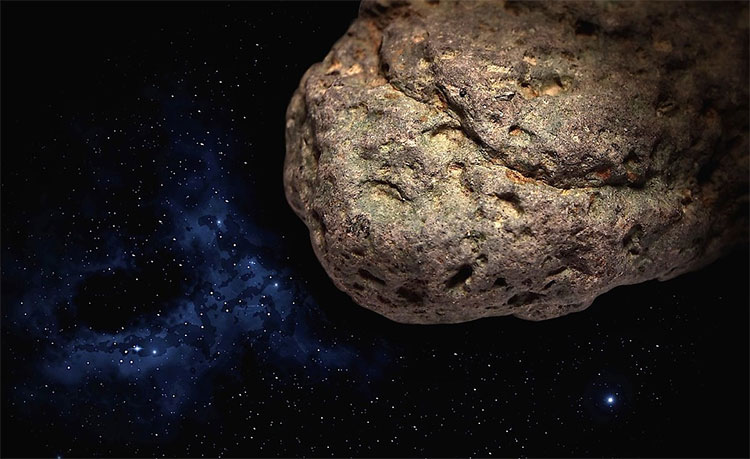Meteors created the oldest rocks of the Earth
According to Nature Geoscience, some of the oldest rocks on Earth can form due to the melting of basalt during the meteorite bombardment of the Earth.
This explains why they contain less silicon and iron than other rocks in the central part of the continent.
In ancient times, when it was just formed, the Earth was bombarded by meteors. Today, it is believed that meteorites fall on the surface and form large holes on Earth. This has a significant impact on the Earth's surface: the rocks melt and mix. However, we have little knowledge of the early life of the Earth, because rocks dating from 3.8 billion years ago are extremely valuable.
Sometimes scientists find smaller zircon particles , belonging to the Archaean era - about 4.4 billion years ago. Some researchers believe that the Earth is covered by a large number of molten felsic rocks , mainly minerals with high silica content.

In ancient times, when newly formed, the Earth was destroyed by meteors - (Photo: Public Domain).
The oldest felsic rock known today is the Idiwhaa gneisses rocks, which are 4.02 billion years old. Idiwhaa gneisses rocks have been found in northwestern Canada. Interestingly, they differ in composition from other felsic rocks that appear in the shells of ancient continents. This suggests that Idvinaha gneisses are formed under the influence of other processes.
To find out the processes responsible for the formation of the oldest felsic blocks, a geological group was conducted by Tim E. Johnson of Curtin University, Australia. The researchers suggest that Idiwhaa gneisses may form when fusing more ancient basalt (mafic rock) with low silica content and high magnesium and iron content.
Scientists have identified the composition of the original earth's crust, as well as the temperature and pressure needed to melt it and form part of Idiwhaa gneisses.
The simulation shows that this process occurs at very low pressure, about 0.1 hectopascal and the temperature is about 800-900 degrees Celsius. According to the researchers, only meteorite bombardment can create conditions so. Geologists have carried out additional modeling, whereby a 10km meteorite falls on the mafic crust (older basalt) at a speed of 12-17km / sec.
It turns out, at a distance of 10 to 50 km from the place where meteorites fall and at depths of up to 3 km, it does form similar rocks in northwestern Canada. According to scientists, felsic rocks are very popular about 4 billion years ago, but because of the process of creation, they almost disappear.
However, science knows very little about the composition of the ancient Earth, so it is impossible to assume for sure what the composition of the Earth's crust is. Perhaps, in the future, geologists will be able to find more evidence to confirm the hypothesis.
- The oldest sign of life
- The 5 largest meteors ever plunged to Earth
- The truth about meteors
- Meteorite hunter
- Found the oldest fossil on Earth
- Meteorites fall and create a giant double hole in Sweden
- Science has confused about the origin of water on Earth?
- The meteorite that cleans humanity is just a matter of time.
- NASA continues to hunt for dangerous meteors
- Russian meteorite turned into
- America uses nuclear weapons to protect the Earth from meteors
- Giant meteors are about to destroy the Earth
 Van Allen's belt and evidence that the Apollo 11 mission to the Moon was myth
Van Allen's belt and evidence that the Apollo 11 mission to the Moon was myth The levels of civilization in the universe (Kardashev scale)
The levels of civilization in the universe (Kardashev scale) Today Mars, the sun and the Earth are aligned
Today Mars, the sun and the Earth are aligned The Amazon owner announced a secret plan to build a space base for thousands of people
The Amazon owner announced a secret plan to build a space base for thousands of people What would happen if you dug a hole through the Earth and jumped in?
What would happen if you dug a hole through the Earth and jumped in?  Chilling discovery of cosmic object that almost brought the Earth to 'apocalypse'
Chilling discovery of cosmic object that almost brought the Earth to 'apocalypse'  The Sun goes into hibernation, will the Earth usher in a new ice age?
The Sun goes into hibernation, will the Earth usher in a new ice age?  Discovery of space object powerful enough to tear apart the Earth
Discovery of space object powerful enough to tear apart the Earth  NASA to test 'pneumatic brakes' for Mars lander
NASA to test 'pneumatic brakes' for Mars lander  Breakthrough discovery of planet with more water than Earth
Breakthrough discovery of planet with more water than Earth 